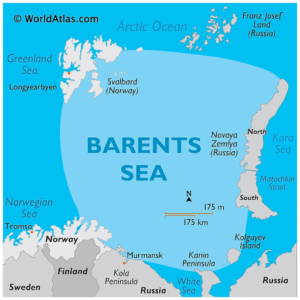In news- According to a study, parts of the Arctic region near Norway are warming at as much as seven times the rate of warming in the rest of the world.
Key highlights of the study-
- Such intense warming has never been observed in the Arctic region before.
- The study was published by the Norwegian Meteorological Institute in the journal Scientific Reports.
- It said the region around the northern Barents Sea, a shallow shelf sea north of Scandinavia, has been warming two to two-and-a-half times the average warming of the Arctic region and five to seven times the warming in the rest of the world.
- In just the last 20 years, the average temperature northeast of the Norwegian archipelago of Svalbard has increased by more than five degrees Celsius.

- The researchers collected and analysed a new large dataset of observations from weather stations on Svalbard and the Russian archipelago of Franz Josef Land in the northern Barents Sea.
- The dataset has temperature observations from northern and eastern Svalbard for the first time.
- The scientists have also used the new climate dataset CARRA, which combines observations with climate models.
- It was already well known that the Arctic is the fastest warming region in the world and the reason for this is a closed loop of melting sea ice and faster warming.
- Lightning strikes, which were once rare in the region, have increased by eight times in the last decade.
- The warming of the region since the 1980s has resulted in the northward shift and increase in abundance of Atlantic fish species and a decrease in the abundance of Arctic fish species.
- The warming of the Barents Sea also led to an extreme snowfall event, often dubbed as the ‘Beast from the East’, across most of Europe in 2018.
- The extreme weather events south of the Arctic are linked to the region’s warming through the Arctic jet stream.
What is Atlantification?
- Atlantification is the increasing influence of Atlantic water in the Arctic.
- The Arctic Ocean is becoming warmer and saltier and sea-ice is disappearing as a result.
- The increasing influence of Atlantic water flowing into the Arctic Ocean and the loss of stratification causes the warm Atlantic water to mix with the fresh water at the surface.
- As the halocline weakens, heat from the Atlantic water reaches the surface and this warming of the surface water causes a retreat in sea-ice in winter and a total absence of sea-ice in summer.
- The loss of winter sea-ice means that the cold freshwater layer at the surface is not replenished in summer by melting ice.
- This causes a weaker definition between the layers in the ocean and a stronger mixing of Atlantic water.
- Also, the loss of sea-ice increases the influence of wind, which mixes the ocean water when there is no ice floating on top.
Source: Down to Earth
















